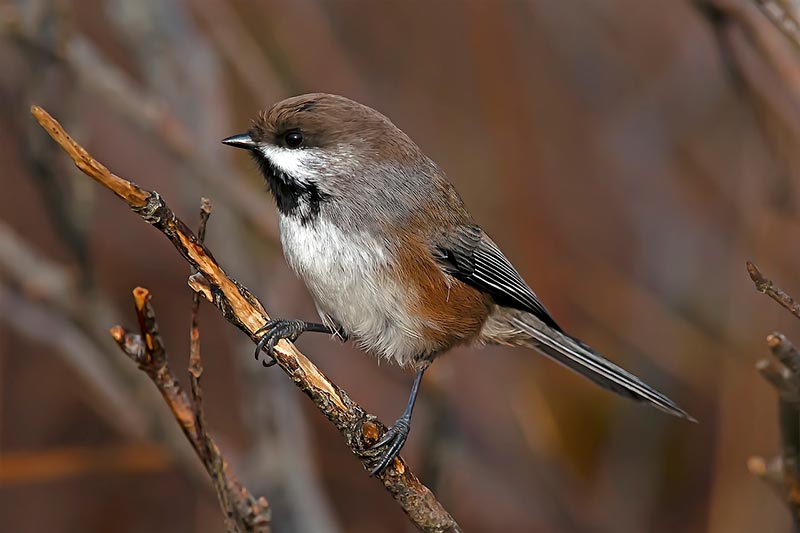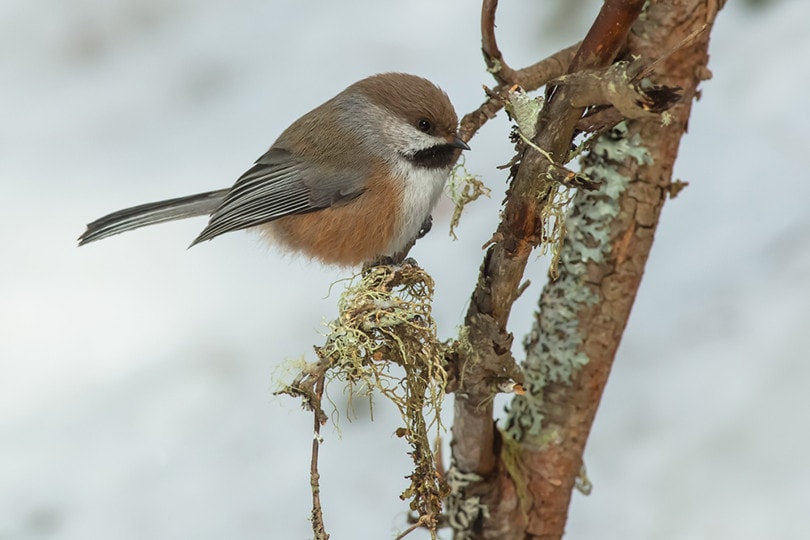Boreal Chickadee: Field Guide, Pictures, Habitat & Info
Last Updated on

The Boreal Chickadee is part of the Paridae or Tit family. The group includes other familiar birds, such as the Tufted Titmouse and the Black-Capped Chickadee. They are all small with little bills. Many are sociable and will come together in flocks or banditries1, the collective name for a band of these birds. They are widespread throughout North America, Eurasia, and Africa.
The chickadees are among a unique number of birds with a name that sounds like their distinctive call. As its name suggests, the Boreal Chickadee lives in colder, northern areas, although it will visit feeders in its range.

Quick Facts about the Boreal Chickadee
| Habitat | Coniferous and boreal forests, spruce bogs |
| Diet | Insects, sunflower seed, peanuts, mealworms |
| Behavior | Diurnal, tree forager; tolerant of humans |
| Nesting | Monogamous cavity nester |
| Conservation | Species of least concern |
| Scientific name | Poecile hudsonicus |
| Lifespan: | 4.2 years |
Boreal Chickadee General Description
The Boreal Chickadee has a buff-colored chest with a black bib and a dark brown cap that goes down to its eyes. It has white cheeks and a dark-colored bill. Its body has a slender tail that is relatively long and has gray legs. It’s quite similar to the Carolina and Black-Capped Chickadees, only lighter in color. This species is about the size of a sparrow.
Five subspecies exist. Each has different ranges and behaviors, which warranted the subsequent categorization of the birds. Males and females have similar coloration and markings. The Boreal Chickadee is larger than its counterparts. It could represent an example of Bergmann’s rule, where birds and mammals often are larger in more northern latitudes.

Boreal Chickadee Range, Habitat, Behavior, Diet & Nesting
The good news about the Boreal Chickadee is that its population isn’t fragmented, although it has decreased in the last several decades like many songbirds. Nevertheless, the International Union for Conservation of Nature and Natural Resources (IUCN) has classified it as a species of least concern. The global estimate is about 13 million birds.
Range
The range of the Boreal Chickadee extends throughout Canada from west to east, into Labrador and Newfoundland. It also lives in Alaska and other parts of the northern United States. Birdwatchers have spotted the birds in northern Minnesota and New England, including Maine. Sightings have also been recorded as far south as Pennsylvania.
The chickadee is typically a year-round, non-migratory bird in most of its range. It visits the United States mainly during breeding. Scientists expect the species’ range to shift north and perhaps out of the lower 48 states altogether if climate change continues on its present course.
Habitat
The Boreal Chickadee is the quintessential inhabitant of coniferous forests. It particularly prefers balsam and spruce trees. It will even follow these species to bogs and swamps. The bird also exists in mixed deciduous woods, especially if willows and alders are present. It will inhabit thick, mature forests during the colder times of the year.

Behavior
The Boreal Chickadee isn’t as vocal as other songbirds. Nevertheless, it is sociable among its kind. You can often spot it climbing up and down trees, scavenging for insects and other foods. It may also poke around loose bark. This bird will cache away food as part of mutual storage for its counterparts. It makes evolutionary sense, considering its habitat and the type of food it eats.
The chickadee also readily feeds on seeds from other trees and in pinecones. It will defend its relatively large territory with displays to make it appear larger by fluffing out its feathers. Like many birds, the Boreal Chickadee has showy courtship rituals, with the male doing acrobatics in the air to attract the female. The pair may engage in feeding behavior before mating.
Diet
The Boreal Chickadee makes good use of its habitat for food and storage. It prefers coniferous trees instead of deciduous species. However, it will take seeds nevertheless. Its primary diet source is insects and larvae, which it finds under tree bark.
Nesting
The Boreal Chickadee is a cavity nester, particularly in dead ones. The pair may use an existing hole or carve out their own to fit their needs. Both sexes will take on this task. The site isn’t usually high, often less than 12 feet off the ground. The chickadee will line its nest with lichen, moss, and pieces of bark. It may even use animal fur.
The female will lay four to nine white eggs with reddish-brown spots. She will incubate them while the male will feed her. The young will hatch between 14–18 days. Both parents will feed the nestlings that are born helpless or altricial. The birds will fledge in about 16–18 days. The pair typically raises only one brood of chicks a season.

How to Find Boreal Chickadee: Birdwatching Tips
The Boreal Chickadee is used to humans, so you shouldn’t have a hard time spotting them in their habitat. They often form small flocks in the winter, making it even easier to see them.

What to Listen For
This bird sings its name, making its identification a piece of cake. Its song is slower than its relative, the Black-Capped Chickadee. It also makes several short chirps and chips, which are usually alarm calls. It also makes a gargling noise if it feels threatened.
What to Look For
Look for the Boreal Chickadee scampering up and down trees, searching for food. It’s an active bird except during the breeding season when it is often more elusive.
When to Look
The Boreal Chickadee is a diurnal bird and is active during the day. It doesn’t have a set pattern. However, you’re more likely to see it in the early morning or late afternoon.

Attracting Boreal Chickadee to Your Backyard: Tips & Tricks
The Boreal Chickadee will gladly visit a well-stocked feeder. It also enjoys suet as a high-energy food source, especially during the winter. Some of its favorite foods include:
- Mealworms
- Peanuts
- Niger
- Safflowers
- Sunflowers
Attracting chickadees or any birds to your yard is more successful if you provide other things they need for survival. Shrubs and small trees will offer welcome shelter and potential nesting sites. A birdbath will also put out the welcome mat. Just be sure to run a heater in it during the colder months.
If you’re walking in the woods, you may get some birds to come closer to you by making the so-called “pishing” noise. It resembles a call many songbirds may recognize. It may spur curiosity in the chickadees to find out what’s happening. However, we recommend only using it to identify the Boreal Chickadee and not using it during the nesting season.

Boreal Chickadee Conservation: Is This Bird Threatened?
The Boreal Chickadee’s numbers have dropped in the last 40–50 years, along with many other avian species. Scientists have detected these declines in annual bird surveys and even weather radar data. Several factors may have contributed to the loss, including climate change and domestic cats. The National Audubon Society estimates the latter takes 2.4 billion birds a year.
The Boreal Chickadee’s remote habitat is a point in its favor and may ultimately safeguard its numbers, no matter what the cause.

Final Thoughts
The Boreal Chickadee is a welcome sight in northern climates if just to enjoy its melodious song. You’ll also have regular visitors if you keep your bird feeder full. While we can still enjoy them, their drop in numbers is a wake-up call.
After all, if common species like this one are in trouble, what does that say about the rest of the avian population? The chickadee reminds us to take care of our planet and all its creatures.
See also:
- Carolina Chickadee: Field Guide, Pictures, Habitat & Info
- Boreal vs Black-Capped Chickadee: How to Tell the Difference
Featured Image Credit: Canadian-Nature-Visions, Pixabay
Table of Contents
- Quick Facts about the Boreal Chickadee
- Boreal Chickadee General Description
- Boreal Chickadee Range, Habitat, Behavior, Diet & Nesting
- How to Find Boreal Chickadee: Birdwatching Tips
- Attracting Boreal Chickadee to Your Backyard: Tips & Tricks
- Boreal Chickadee Conservation: Is This Bird Threatened?
- Final Thoughts
About the Author Chris Dinesen Rogers
Chris has been writing since 2009 on a variety of topics. Her motto with all of her writing is “science-based writing nurtured by education and critical thinking.” Chris specializes in science topics and has a special love for health and environmental topics, and animals of all shapes and sizes.
Related Articles:
10 Types of Hummingbirds in Arkansas (With Pictures)
8 Types of Hummingbirds in Nebraska (With Pictures)
5 Types of Hummingbirds in Idaho (With Pictures)
3 Types of Hummingbirds in Mississippi (With Pictures)
8 Types of Hummingbirds in Kansas (With Pictures)
5 Types of Hummingbirds in West Virginia (With Pictures)
5 Types of Hummingbirds in Ohio (With Pictures)
Where Do Nuthatches Nest? Nuthatch Nesting Habits Explained
